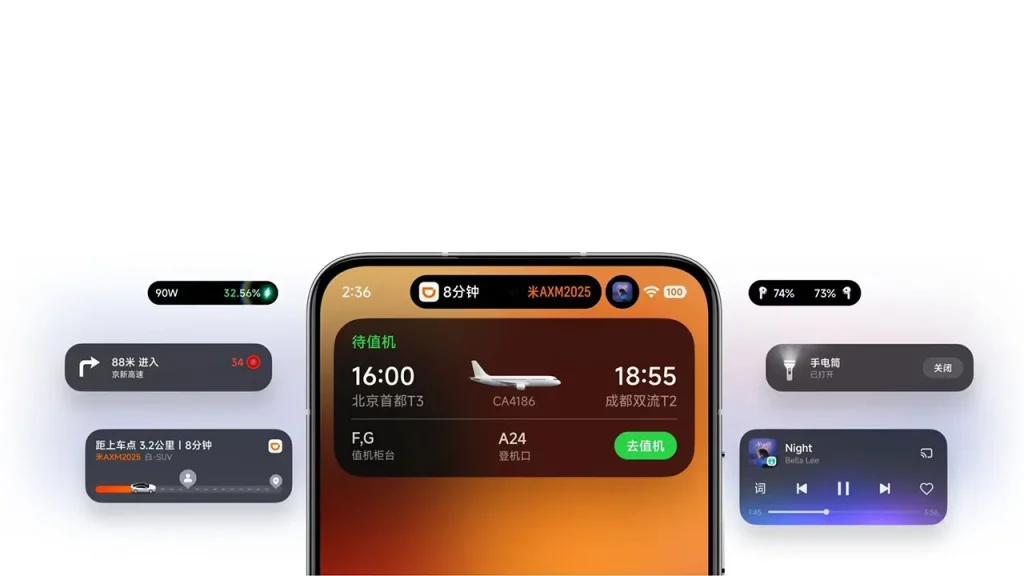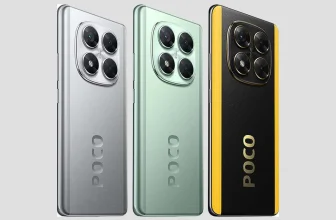
After years of ruling with its famous user interface, MIUI, Xiaomi has finally decided to make a major overhaul and start a completely new path with the introduction of HyperOS. HyperOS 3, the latest version of this operating system, is not just a simple update with a few new icons; it is a statement. A statement that shows that Xiaomi is no longer just thinking about mobile phones and has a much bigger goal in mind: building a smart and integrated ecosystem called Human x Car x Home. This means that HyperOS is going to be the brainchild of all Xiaomi products, from phones and tablets to smartwatches, home appliances and even the company’s electric car.
To understand how serious this claim is, we need to look at the technical structure of HyperOS. The operating system is built on top of Android 16, but Xiaomi has added a deeper layer called Vela that allows it to make more fundamental changes at the system level. This means that HyperOS is not just a skin or launcher on top of Android, but a real operating system with more control over the hardware and software.
An overview of the new features of HyperOS 3
Why is this name change from MIUI to HyperOS so important? It’s more than just a publicity stunt. The word UI in MIUI stood for User Interface, which subconsciously conveyed the feeling that we were dealing with a skin on top of Android. But the word OS in HyperOS stands for Operating System, which means Xiaomi is upgrading its software from a mobile user interface to a fundamental platform. When you’re going to control a smart car, you need an operating system, not just a pretty UI. This name change actually shows Xiaomi’s foresight to compete directly with powerful ecosystems such as Apple (iOS/macOS), Google (Android/ChromeOS) and even Huawei (HarmonyOS). The main goal is for Hyper OS to solve the old problems of MIUI such as being heavy, having too many extra apps (Bloatware) and performance degradation over time and provide users with a lightweight, fast and optimized user experience. Xiaomi Poco X7 Review
Before we go into the full dissection of Hyper OS 3, let’s take a quick look at its most important and exciting new features to get an idea of what we are dealing with:
- Super Island: A new dynamic and interactive section at the top of the screen that displays notifications and live activities in an attractive way.
Extensive Lock Screen Personalization: Unique lock screen customization capabilities with new styles, fonts, and depth-of-field effects that we have rarely seen before in the Android world. - HyperAI: A complete set of AI tools to help with writing, professional photo editing, and intelligent system management.
- HyperConnect integrated ecosystem: An incredibly powerful communication system that allows your Xiaomi phone to easily communicate with even Apple and Windows devices.
- Performance improvements: A faster, lighter, and more optimized operating system with better battery life and fewer extra apps.
HyperOS 3 Dissection; From Dynamic Island to Xiaomi’s AI
Now it’s time to go deeper and see how each of these features works in practice and what impact they have on our user experience.
Super Island; A copy of the original Dynamic Island or something better?
The first thing that catches your eye in Hyper OS 3 is the Super Island feature. Yes, it’s called a lot like Apple’s Dynamic Island, and it works exactly the same. It’s a black oval bar at the top of the screen that interactively displays important information and live activities like battery status, incoming calls, music controls, and notifications.
But Xiaomi didn’t just copy it. The Super Island feature is more interactive; for example, you can tap it to enlarge it, swipe it to switch between multiple activities, or swipe it down to go directly to the app. Xiaomi even claims that it has a three-island design that allows you to see multiple pieces of information at the same time. This means that the focus has been on efficiency and multitasking from the start.

There’s something clever about Xiaomi’s move. They waited, analyzed the strengths and weaknesses of Apple’s Dynamic Island, and tried to deliver a more complete and functional version from day one. The focus on managing multiple apps without leaving the current screen was precisely one of the criticisms that were leveled at the initial version of Dynamic Island. But there is a big challenge; the global success of this feature depends entirely on how much popular app developers (such as Spotify, Uber, WhatsApp, etc.) support it. Xiaomi says that more than 70 services currently support Super Island, but most of them are specific to the Chinese market. If global developers do not embrace the feature, Super Island in the global version of Hyper OS may become a fancy feature that only works with Xiaomi’s own apps.
Redmi Note 14 Pro 4G Review: Xiaomi’s Mid-Range Beast?
HyperOS-style customization; a lock screen that you create yourself
One of the biggest visual changes in HyperOS is the Lock Screen customization section, which is boldly inspired by Apple’s iOS 16 and very well implemented. You now have complete control over the appearance of your phone’s lock screen and can design it exactly how you like.
The system has three main styles:
- Classic: This style displays the time, date, and weather information. You can add your signature to it or bring various information widgets such as humidity level, UV index, and… to it. Of course, this mode does not support the depth of field effect.
- Rhombus: A modern and minimal design that focuses on a large and attractive clock display. You can choose your favorite option from several clock styles and colors.
- Magazine: This is the most attractive and advanced style. With this feature, you can make your personal photos look like magazine covers. Its most important feature is the support for the depth of field effect, which allows the time and date to be placed behind the main subject of your photo, creating a wonderful 3D feeling. In addition, you can fully customize the fonts, colors, and placement of the text.
In addition, Hyper OS can create animated and cinematic wallpapers with the help of artificial intelligence and turn your still photos into dynamic backgrounds. This level of customization is a big step for Xiaomi and directly challenges one of Apple’s main strengths. This shows that the competition in the mobile world is no longer just about hardware, and the user experience and personalization of appearance have become as important as the processor and camera.
Xiaomi’s new brainchild; HyperAI
Artificial intelligence is the beating heart of HyperOS 3. Xiaomi has included a whole suite of smart tools called HyperAI in this operating system that makes everyday tasks much easier and more engaging.
AI-powered writing tools: With the help of Google’s Gemini AI model, you can now change the style and tone of your writing in messages and emails. For example, turn a formal text into a personal and friendly text.
- AI in Gallery: This section has really changed:
- AI Expand: With this feature, you can enlarge the frame of your photos. By analyzing the photo, AI reconstructs its surroundings in a completely natural way, as if you had taken the photo with a wide lens from the beginning.
- AI Erase: You can easily remove people, objects, electrical wires or any extra things from your photos. AI intelligently fills in their gaps.
- AI Portrait and AI Sky: You can create artistic portraits with AI or change the sky of your photos with different options (sunny, sunset, starry night, etc.) in a completely realistic way.
- AI for productivity:
- Live transcription and summarization: Hyper OS can convert the audio of meetings or classes into text live and even provide summaries of them.
- Smart search in the gallery: You no longer have to search for something specific among thousands of photos. Just write beach photos in colloquial language and the system will find all related photos for you.
- Circle to Search feature: Similar to Pixel and Samsung phones, you can draw a circle around anything on the screen to get Google to provide information about it.
The important point is that Xiaomi, with the help of Gemini Nano, performs some of these AI processing on the device itself and does not need to send information to cloud servers. This both increases speed and protects user privacy. Of course, Xiaomi has a dual strategy; in the Chinese market, it uses its own proprietary AI, XiaoAI, and in the global market, it uses Google’s powerful and well-known Gemini model. This is smart, but it also raises concerns that perhaps the best and most integrated AI capabilities will remain limited to the Chinese version, and global users will experience a lighter version of HyperAI.
A unified ecosystem; when all your devices talk to each other
This is where HyperOS really shines and shows why it is an operating system, not just a user interface. The backbone of this ecosystem is HyperConnect technology, which makes communication between different devices incredibly fast and smooth.
- Unique phone-tablet connection:
- Home Screen+: You can cast your phone screen to the tablet and control your phone completely from the tablet.
- Shared Clipboard: Copy a text or image on your phone and paste it on the tablet, it’s that easy!
- Tap to Share (NFC): Just bring your phone and tablet close together to transfer files instantly.
- Notification sync: All notifications from your phone are displayed on the tablet as well.
- Beyond phones and tablets: This integration extends to smartwatches (for example, you can see your heart rate data on the video while filming sports), smart home appliances, and even Xiaomi cars.
But the most surprising part is the ability to connect with non-Xiaomi devices, especially Apple products. This is an aggressive and very smart move on Xiaomi’s part.
- Connection to the Apple ecosystem: HyperOS allows you to run Xiaomi phone apps on iPad and Mac, see phone notifications on iPhone, and easily transfer files between these devices.
- Connection to Windows: The Link to Windows feature is also fully supported, and you can access phone content from your Windows PC.
This strategy changes the rules of the ecosystem game. Instead of building a walled garden like Apple, Xiaomi is building a bridge to other ecosystems. The company understands that many users in the real world use a combination of different brands (for example, a Xiaomi phone and a MacBook laptop). By doing this, Xiaomi is telling these users; you don’t need to change your MacBook, our phone works better with it than any other Android phone. This is a huge competitive advantage that can attract many users.
Under the skin of the operating system; improved performance and security
HyperOS doesn’t just look new, it is also engineered from the ground up for better performance and higher security. - Performance and optimization:
Xiaomi claims that gaming performance is up to 15% better and apps run 21% faster. - The size of the operating system itself has been significantly reduced, from about 12 GB in MIUI to about 9 GB. This means that more storage space is freed up for you.
- More efficient management of hardware resources has led to better battery consumption in most cases. Of course, some users complained about higher battery consumption after the update, which is normal in early updates and usually resolves over time.
- The number of additional programs (Bloatware) has decreased and, more importantly, you can now remove more system apps that you don’t need.
- Security (TEE):
- One of the most important improvements of HyperOS is the use of a dedicated hardware security system called TEE (Trusted Execution Environment).
- TEE creates an isolated and secure section on the processor itself that stores your extremely sensitive information such as fingerprints, facial recognition information, passwords, and personal files. This means that even if the entire Android operating system is hacked, hackers will not be able to access this section.
- The important thing is that this security feature is available on all phones that receive HyperOS, not just flagship models. This move is a direct response to user security concerns and an attempt to gain trust in global markets.
New look and feel; Small and large changes to the HyperOS 3.0 user interface
Although HyperOS is a major change in terms of structure, Xiaomi has acted wisely and has not changed the overall look of the operating system in a revolutionary way so as not to confuse old MIUI users. The changes are mostly aimed at modernizing and making the user interface cleaner.
Control Center: The design of the Control Center has been completely changed. It is now cleaner and more iOS-like. The text labels under the icons have been removed (of course, you can rotate them), the icons have become larger, and various settings have become easier to access.
Gallery app: The gallery has also been given a makeover. The layout of albums and access to editing tools has been made more logical and modern, and a new tab called Recommended has been added for quick access to AI features.
Animations: More than 100 new animations have been added to the system or existing animations have been improved. Opening and closing apps, switching between menus, and all interactions with the phone now feel smoother and more fluid. - Overall aesthetics: The overall design has shifted towards minimalism. Rounder corners of windows, frosted glass effects, and the new, more readable MiSans font all give HyperOS a modern and classy feel.
Xiaomi HyperOS 3 Update: Expected Timeline & Unofficial Device List
| Category | Details |
|---|---|
| Expected Stable Release | Late September – Early October (for the first batch of devices) |
| Beta Testing Phase | Reportedly began in August |
| Note | The timeline is approximate and subject to change. The official list has not been announced by Xiaomi. |
Unofficial List of Eligible Devices
| Brand / Series | Specific Models / Series |
|---|---|
| Xiaomi Series | Xiaomi 15 Series (15, 15 Pro, 15 Ultra, 15S Pro) • Xiaomi 14 Series (14, 14 Pro, 14 Ultra, 14 Civi) • Xiaomi 14T Series (14T, 14T Pro) • Xiaomi 13 Series (13, 13 Lite, 13 Pro, 13 Ultra) • Xiaomi 13T Series (13T, 13T Pro) • Xiaomi 12 Series (12, 12 5G, 12 Pro, 12 Pro Dimensity, 12 Lite, 12 Lite NE) • Xiaomi 12S Series (12S, 12S Pro, 12S Ultra) • Xiaomi MIX Flip & MIX Fold • Xiaomi Pad 6 & Pad 7 Series |
| Redmi Series | Redmi Note 14 Series • Redmi Note 13 Series • Redmi Note 12 Series (Select models: 4G, 4G NFC, 12S, 12 Turbo, 12T Pro) • Redmi 15, 14, 13, 12 Series • Redmi A Series (A5 4G, A4 5G, A3 Pro) • Redmi K Series (K80, K70, K60, K50 Ultra) • Redmi Turbo Series (Turbo 3, Turbo 4) • Redmi Pad Series |
| POCO Series | Poco F Series (F7, F6, F5) • Poco X Series (X7, X6) • Poco M Series (M7, M6) • Poco C Series (C75, C65) |
This evolutionary rather than revolutionary approach shows that Xiaomi respects its large user base and doesn’t want to alienate them with a sudden change. The goal was to make the operating system both attractive to new users and familiar and comfortable for existing users.
Xiaomi HyperOS 3 Review Summary
Well, we’ve come to the end of the review. HyperOS 3 is undoubtedly a hugely important update and a big step forward for Xiaomi. It’s not just a new name for MIUI, but a new platform that will shape the future of the company’s products.
Key Strengths:
- Integrated and forward-looking ecosystem: The ability to seamlessly connect different devices, especially the bridge with Apple products, is a huge competitive advantage.
- Practical AI: HyperAI tools are really useful and go beyond the advertised features.
Better performance and lighter: HyperOS is faster, smoother, and lighter than MIUI, offering a better user experience. - Deep customization: The new lock screen customization features are fun and engaging, giving the user a greater sense of control.
Weaknesses and concerns: - Differences between the Chinese and global versions: This is the biggest concern. There is always a risk that the best and most interesting features (especially in the AI and Super Island sections) will remain limited to the China version.
- Dependence on developers: The global success of features like Super Island depends entirely on the support of third-party app developers.
- Too much iOS inspiration: While the features are well implemented, the close resemblance to iOS may not be pleasant for those looking for a pure and unique Android experience.
- Early bugs: Like any new operating system, early versions may have bugs such as high battery consumption, which will be fixed over time.
HyperOS 3 is a necessary and very valuable update that shows that Xiaomi has big plans for the future. If your phone is getting this update, be sure to update, especially if you use several Xiaomi products or are interested in AI and personalization features. This OS will take your phone experience to a new level. However, if you’re being extra cautious, it might be best to update a few weeks after the public release so that any potential bugs can be ironed out. Either way, the future of Xiaomi’s software is here, and it looks like it has a bright future ahead of it.



